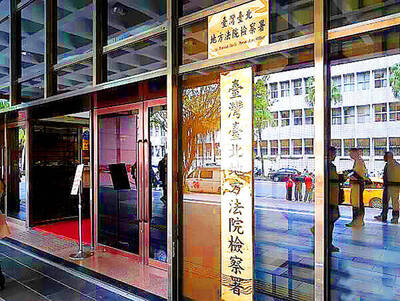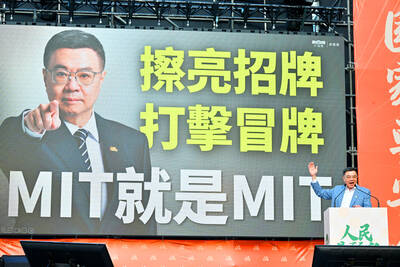Authorities in eastern China covered up an outbreak of cholera for 12 days out of fears that publicizing the often fatal disease would shock the local population, state press said yesterday.
According to the Anhui Province health department’s Web site, 38 people have contracted cholera since Aug. 16 and the outbreak was under preliminary control with the numbers of cases diminishing.
Five patients remain hospitalized, it said.
Cholera causes serious diarrhoea and vomiting, leading to dehydration, and can be fatal if not treated quickly. It normally breaks out in impoverished regions with poor sanitation.
Although health authorities have not reported any deaths, Internet chatrooms were abuzz with rumors that several people have died from the disease.
At the same time state media criticized the government for covering up the epidemic and refusing to alert the local population.
“On August 16, the Anhui centre for disease control had confirmed the outbreak of cholera, but it was not until August 28 that it was publicized,” the Beijing News said in an editorial. “The government covered up the outbreak for 12 days.”
The paper quoted Wang Jianjun (王建軍), the vice director of the Anhui Center for Disease Control as saying that local officials were powerless to publicize disease outbreaks and had to wait for approval from more senior officials.
“Besides, if every outbreak of disease is publicized every time, this will easily lead the public to become paralyzed in their thinking,” the report cited him as saying without elaboration.
The cholera outbreak has been traced to soybean milk shop in Mengcheng city.
Poor sanitation and a lax food safety regime have repeatedly led to health scares in China.
Last week, 87 children were hospitalized after eating tainted yogurt at a kindergarten in Gansu Province, state media reported on Saturday.
A cooking oil company in central China also admitted last week it had waited five months before notifying the public that one of its products had been found to contain excessive carcinogens.

INVESTIGATION: The case is the latest instance of a DPP figure being implicated in an espionage network accused of allegedly leaking information to Chinese intelligence Democratic Progressive Party (DPP) member Ho Jen-chieh (何仁傑) was detained and held incommunicado yesterday on suspicion of spying for China during his tenure as assistant to then-minister of foreign affairs Joseph Wu (吳釗燮). The Taipei District Prosecutors’ Office said Ho was implicated during its investigation into alleged spying activities by former Presidential Office consultant Wu Shang-yu (吳尚雨). Prosecutors said there is reason to believe Ho breached the National Security Act (國家安全法) by leaking classified Ministry of Foreign Affairs information to Chinese intelligence. Following interrogation, prosecutors petitioned the Taipei District Court to detain Ho, citing concerns over potential collusion or tampering of evidence. The

Seventy percent of middle and elementary schools now conduct English classes entirely in English, the Ministry of Education said, as it encourages schools nationwide to adopt this practice Minister of Education (MOE) Cheng Ying-yao (鄭英耀) is scheduled to present a report on the government’s bilingual education policy to the Legislative Yuan’s Education and Culture Committee today. The report would outline strategies aimed at expanding access to education, reducing regional disparities and improving talent cultivation. Implementation of bilingual education policies has varied across local governments, occasionally drawing public criticism. For example, some schools have required teachers of non-English subjects to pass English proficiency

NEGOTIATIONS: The US response to the countermeasures and plans Taiwan presented has been positive, including boosting procurement and investment, the president said Taiwan is included in the first group for trade negotiations with the US, President William Lai (賴清德) said yesterday, as he seeks to shield Taiwanese exporters from a 32 percent tariff. In Washington, US Trade Representative Jamieson Greer said in an interview on Fox News on Thursday that he would speak to his Taiwanese and Israeli counterparts yesterday about tariffs after holding a long discussion with the Vietnamese earlier. US President Donald Trump on Wednesday postponed punishing levies on multiple trade partners, including Taiwan, for three months after trillions of US dollars were wiped off global markets. He has maintained a 10 percent

TRADE: The premier pledged safeguards on ‘Made in Taiwan’ labeling, anti-dumping measures and stricter export controls to strengthen its position in trade talks Products labeled “made in Taiwan” must be genuinely made in Taiwan, Premier Cho Jung-tai (卓榮泰) said yesterday, vowing to enforce strict safeguards against “origin laundering” and initiate anti-dumping investigations to prevent China dumping its products in Taiwan. Cho made the remarks in a discussion session with representatives from industries in Kaohsiung. In response to the US government’s recent announcement of “reciprocal” tariffs on its trading partners, President William Lai (賴清德) and Cho last week began a series of consultations with industry leaders nationwide to gather feedback and address concerns. Taiwanese and US officials held a videoconference on Friday evening to discuss the